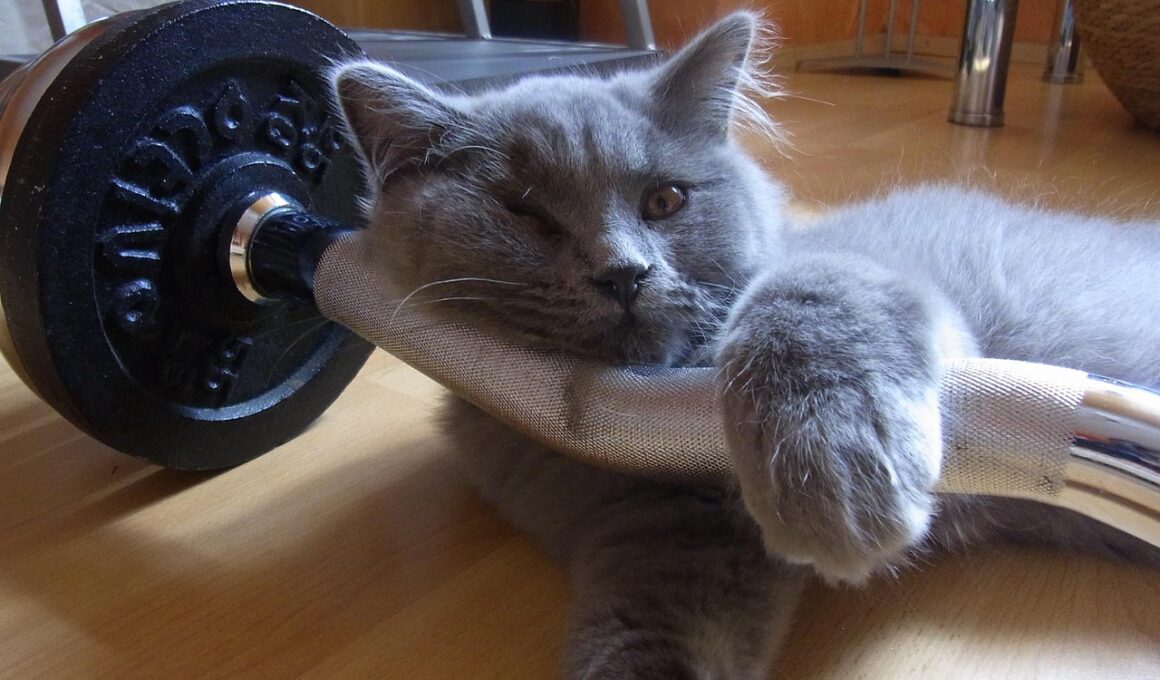How to Make a DIY Cat Tree Training Station at Home
Creating a cat tree training station at home is an excellent way to help your feline friends get accustomed to this essential piece of furniture. First, you need to gather materials that are both sturdy and safe for your cats. Common options include plywood, sisal rope, and carpet scraps. Focus on the structure’s height and stability, ensuring it won’t wobble while your cat explores. A well-designed structure promotes climbing and scratching, satisfying their natural instincts. If you’re on a budget, consider using old furniture parts instead of brand new materials. To enhance the appeal, incorporate platforms at varying heights, allowing your cats to climb and perch comfortably. Make sure these platforms are appropriately spaced for easy access. Adding ramps can help facilitate movement, especially for older cats. Additionally, don’t forget to include a scratching post element, as this will encourage healthy scratching habits. You can find various DIY plans online that outline different designs for cat trees, showcasing diverse styles and materials that could be implemented. Choose a design that aligns well with your home decor.
Your choice of location is equally crucial when setting up your DIY cat tree training station. Think about placing it near windows, as cats enjoy observing outside activities. Positioning the tree in a high-traffic area of your home also ensures your cat will encounter it regularly, promoting usage. Keep in mind that cats like to retreat to elevated spaces where they feel safe. To make the area more enticing, consider incorporating some toys. Hanging feather wands or other interactive toys can stimulate your cat’s playful instincts. When your cat feels comfortable in this environment, they will be more likely to get used to the cat tree gradually. Another beneficial tip is to use treats to encourage your cat to explore the cat tree. Offering a reward when they climb to a certain height will positively reinforce the behavior. You should monitor your cat’s progress and adjust the training methods as required. Always ensure that the materials used are safe and non-toxic. Pay attention to your cat’s preferences and layout adjustments over time to cater to their evolving needs.
Design Considerations for Cat Trees
When designing your cat tree, consider the needs and preferences of your cat. Various aspects contribute to making a successful training station. First, height is essential; provide multiple levels for climbing while ensuring solid stability. The larger the surface area of each platform, the safer and more comfortable it is for your feline. Materials matter too; soft carpets encourage lounging while sisal provides the perfect texture for scratching. Cats instinctively seek out items to scratch, and incorporating natural elements like cardboard or wood satisfies this need. Stability is also vital; a wobbly cat tree can result in accidents. Make sure to use strong cushioning for any soft areas to minimize injury risks. Varied textures can improve their experience; mix surfaces like wood, cardboard, and fabric. Adding cozy spaces like enclosed cubbies or hammocks can provide them with safe havens for relaxation. Ensure accessibility for all ages and sizes of cats, considering ramps or steps. Finally, aesthetic appeal is important. Designing a cat tree that harmonizes with your home can enhance its acceptance by both cats and humans.
To further encourage your cat to use the training station, consider incorporating elements that stimulate their curiosity. You can add hanging toys or even a few treats in the nooks of the cat tree. Providing a stimulating environment is crucial for your cat’s happiness. Try painting or decorating the cat tree sleekly for a cohesive look with your home. Additionally, offering various levels, platforms, and tunnels will help your cat find joy and interest in climbing and exploring. Cats may gravitate towards different areas based on their mood; giving them options is key. Another significant aspect is the understanding that patience is essential during training. Your feline buddy might not take to the cat tree immediately, so encouraging exploration is important. Use soft encouragement, like gentle pats or positive vocal tones, to let them know they are doing well. If they engage with the new structure, make sure to reward them regularly to build their confidence. Monitoring interactions will also help identify what areas feel most appealing to them, and adjustments can be made accordingly to enhance their experience.
Maintenance of the Cat Training Station
Having your DIY cat tree training station in good condition is crucial for encouraging your cat’s usage. Regular maintenance helps prevent wear and tear while ensuring a safe experience for your pet. Inspect the tree frequently for any loose screws or damaged materials. If you notice wear, it’s essential to make necessary repairs immediately to prevent injury. Regularly cleaning the surfaces is also important. Fur and dander can accumulate over time, making it unpleasant for both cats and humans. Use a vacuum or brush to thoroughly clean the structure and prevent dust buildup. You can also sanitize surfaces occasionally by using pet-safe cleaning products. Additionally, consider rotating the toys and treats that you place around the cat tree to keep it fresh and engaging. If you’ve added ramps and tunnels, ensure they are secured tightly and maintain their stability. Reinventing an aspect once in a while can spark your cat’s interest and lead them to explore more. A well-maintained cat training station not only prolongs the life of the structure but also enriches your feline’s experience.
Furthermore, understanding your cat’s body language can greatly enhance the training process. Pay attention to their signals; curious cats often take slow, direct paths towards their targets. If your cat shows interest by approaching the cat tree, encourage exploration through vocal praise or treats. Conversely, if they appear disinterested or hesitant, reassess the environment for stressors. A busy, noisy location might deter them, so consider moving the tree to a calmer area. Offering quiet zones around the cat tree can also improve their comfort level. Experiencing varying textures encourages exploration; you might even experiment with different items on the platforms. By observing their interaction daily, you will start recognizing their preferences within the space. It’s essential to create an environment where they feel empowered to explore. Introducing gradual changes and reinforcements when interacting with various elements helps build confidence in using the cat tree effectively. As they become comfortable with their training station, regularly engaging with them will help solidify the appreciation for their new space.
Integrating Cat Trees with Other Supplies
Integrating your DIY cat tree training station with other cat supplies enhances your pet’s overall experience. It can be beneficial to position it near items your cat already enjoys, such as food bowls or beds. This familiar proximity can ease the transition and entice them to investigate the new environment. Adding cozy spaces like blankets or small beds can also invite your cat to lounge on the tree. Implementing post-training activities that align with their needs additionally enriches their environment. For example, you could provide a scratching post nearby to encourage healthy behavior. Use enticing scents like catnip on certain areas, as this will draw them in and lead to natural exploration. You might also consider having interactive toys nearby to maintain stimulation. Observe their behavior to find the right balance between activity and relaxation. Make adjustments based on their interactions and reactions to create a space they truly cherish. Ultimately, the more integrated these supplies are, the more likely they will engage positively with their new cat tree training station.
In conclusion, setting up a DIY cat tree training station offers numerous benefits for your feline companions. It fosters their natural instincts to scratch, climb, and explore. Selecting appropriate materials and designing for stability is essential in creating a safe environment. Finding an ideal location and incorporating interactive supplies encourages familiarity and accessibility. Regular maintenance keeps the tree in optimal condition and contributes to a lasting experience. Pay attention to their body language and adjust strategies to enhance their engagement with the cat tree. Integration with other pet supplies creates a rich, stimulating environment that nurtures their playful spirit. Ultimately, your patience and dedication will yield a positive outcome for both you and your cat. Observing the joy and confidence your feline shows while using the training station helps affirm your efforts. Over time, you will witness remarkable transformations in their behavior, and their fondness for the cat tree will be evident. Enjoy the journey together as you create a lavish space that enhances their lifestyle and accommodates their needs.


